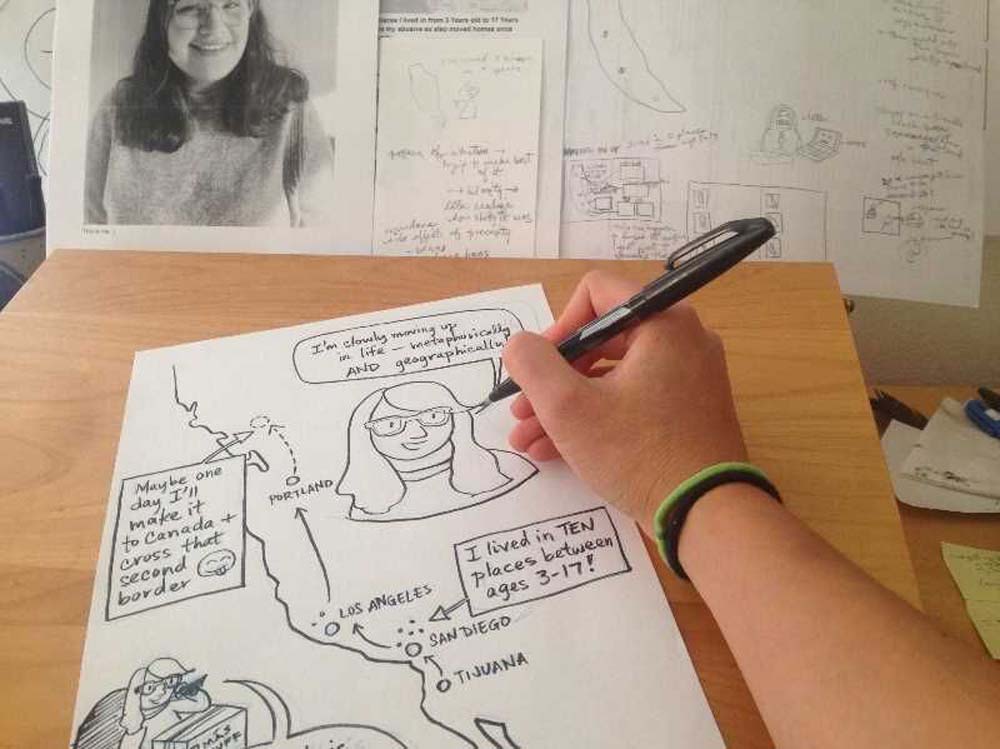Experiencing houselessness? See you in the unfunny pages
Published 12:00 am Thursday, February 3, 2022

- "Caldo Pa' Las Cruda", drawn by Christina Tran, tells Daniela's story, as her family leaves its small farm in Tijuana and moves to the US, living in a series of run-down apartments.
Regular purchasers of Street Roots will see a supplement on sale in February: A comic book about homelessness.
Trending
A researcher at Portland State University’s Homelessness Research & Action Collaborative (HRAC) sat down with 10 students (by Zoom) and interviewed them about their experiences of homelessness and housing insecurity. The comic book is called “Changing the Narrative: Stories of Student Homelessness and Housing Instability” and it’s a scholarly work in cartoon form — albeit dark cartoons.
Researcher Dr. Kacy McKinney, a faculty member in the Toulan School of Urban Studies and Planning at PSU, and two student research assistants did the interviews, then submitted anonymized materials to comic book artists, who turned them into picture and word narratives. Some of the artists are very well-known. One is Arantza Peña Popo (she/they) who calls herself an “Angsty Afro-Latina Comic Artistco” on Instagram (@_ara_pena_) and whose single panel work has been seen in the New Yorker.
“My hope is that these stories, these works of art, will resonate. I hope that they will touch people in unexpected ways, and change the way we think, talk and teach about homelessness and poverty,” said McKinney.
Trending
The stories focus on marginalized voices. They are mostly about women of color, often queer, moving from house to house, trying to support themselves, look after their families and study at the same time. Landing at Portland State University is part of their journey — but it doesn’t always guarantee relief from housing insecurity.
Popo’s work is about a female PSU student whose father, back home in Uganda, loses his job. The lack of income leaves her locked out of her student account and with few options, struggling with bureaucracy while trying to find a new place to live. The tale, called “Not finishing was not an option” shows the student relocating with a family from church, with a three-hour bus commute from the university. She shares a room with their newborn baby. Eventually, a school advisor helped her get a scholarship so she can move into a tiny dorm. Despite more stress, she gets her master’s degree and returns to Uganda, where her dad has just got a new job too. It’s a happy ending, told in full color in the final panel, and it credits her privilege and the individuals who helped her survive.
“Toward Light” by Marin Jurgens, tells the woeful tale of a young Vietnamese American woman escaping an abusive partner with her infant, finding friendly peers in a transitional housing center for women, dodging the former partner, and finally fleeing to Oregon.
“Caldo pa’ la Cruda”, drawn by Christina Tran, tells Daniela’s story, as her family leaves its small farm in Tijuana and moves to the US, living in a series of run-down apartments. There are child’s-eye details, such as a cockroach emerging from the toilet roll tube and folding a mattress like a taco to make it fit in a car, on yet another moving day. By the end, Daniela moves to Portland, becomes a business coach, and makes a close friend who becomes a roommate.
In “Strings Attached”, drawn by Erika Rier, the pattern continues of someone fleeing abuse into housing insecurity. The lead character heads to Portland to go to graduate school. Cue the final panel of them sitting in a forest with a cat/dog on their lap.
“The Moon and the Window Seat,” is beautifully drawn by Gigi Woolery. In it, a girl on a reservation in New Mexico talks about her five-person family having only one gallon of water a day. When they drove into town, she would read in the public library, then drink as much from the water fountain as she could before they headed home. She had no toys or books, only flowers. She often slept under the stars. She joined the military and had a sense of home for the first time. Then she moved to Portland to pursue a graduate degree at PSU, where she was mentored by Professor Judy Bluehorse Skelton. She ends by saying she might rejoin the military, so her kids don’t have to support her in her old age.
Quinn Amacher was assigned the story of Lee (a pseudonym) who was kicked out of his home on coming out as a trans man in the 1990s. The story, “Street Lights”, focuses less on Lee and more on the people around Lee. This comprised a community of 300 street kids, such as Sage, “a talented shoplifter who only stole to give things as gifts”, and Hope, an artist whose funeral Lee’s friends crashed, in spite of the family’s wishes. There’s no real narrative other than “I survived with the help of these people.” Amacher has her own colorful comic series, “Syncing”, but in “Street Lights” her watercolors highlight the humans, giving them an aura in a monochrome city.
Amacher enjoyed drawing “Street Lights”, adding small panels within full bleed drawings (that go to the edge of the page), and using a jagged gutter (the white bar between two drawings) shaped like a heart rate monitor.
“It’s not a story of powerlessness, but of the pressures put upon trans people,” Amacher told the Portland Tribune. “Being a trans person myself, having experienced some of that same discrimination, although never to the extent that it forced me into houselessness, I really empathize with Lee.”
INFOBOX
“Changing the Narrative: Stories of Student Homelessness and Housing Insecurity” is on sale by Street Roots vendors in February.
Panels from the comics are on display Feb. 12 and 13 at the Downstairs Gallery, 124 SW Yamhill St.,
The project was funded by the Homelessness Research and Action Collaborative, in collaboration with Street Roots and the Independent Publishing Resource Center, the artists were paid, and PSU owns the copyright to the final works.







